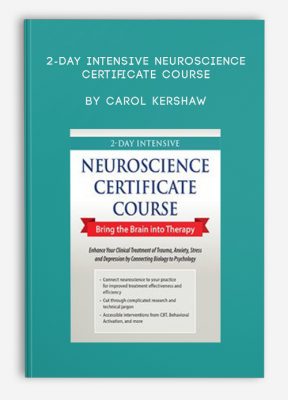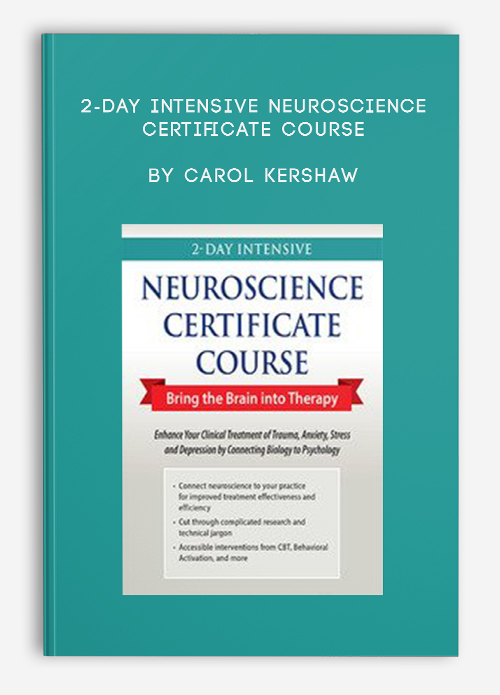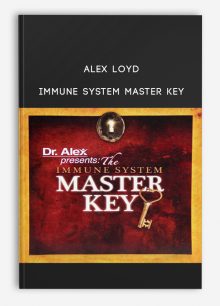2-Day Intensive Neuroscience Certificate Course by Carol Kershaw
$219.00 $65.00

2-Day Intensive Neuroscience Certificate Course Bring the Brain into Therapy by Carol Kershaw, Bill Wade
Faculty:Carol Kershaw | Bill Wade
Duration:12 Hours 13 Minutes | Format:Audio and Video
Archive : 2-Day Intensive Neuroscience Certificate Course by Carol Kershaw
Get 2-Day Intensive Neuroscience Certificate Course by Carol Kershaw on Salaedu.com
Outline:
Motivate and Engage Your Clients with Neuroscience
- Simple explanations on brain structure and function
- The neurobiology of specific disorders
- You can change – neuroplasticity and the potential for transformation
Teach Clients About Brain Health
- Sleep quality and mood
- Nutrition
- The habit of exercise
- The value of social support
- Detrimental impacts of stress
How the Neurobiology of Attachment and Relationships Informs Your Clinical Practice
- Neurobiological basis of attachment
- How relationships impact our brains
- Mirror neurons, empathy and connecting with others
- Oxytocin and the individual self
- How attachment style impacts your clients’ relationships
- Attachment and attunement in the therapeutic relationship
Trauma: Connect the Neurobiology of Trauma to Treatment
- Childhood trauma and the trajectory of brain development
- The fight/flight/freeze response
- Implicit memory and the limbic system
- Clinical techniques:
- Trigger identification
- Exposure
- Guided imagery
- Grounding strategies
Anxiety and Stress: Regulate Emotion and Interrupt Anxious Rumination
- How the brain is organized – and how it organizes
- Homeostasis, stress pathways and stress responses
- The resting state – the parasympathetic nervous system and mental health
- Emotional and thinking circuits, and perception of control – and why this matters to therapy
- Clinical techniques:
- Mindful awareness of emotions – labeling emotions
- Interventions that shift focus away from anxious rumination
- Interrupt worry patterns with physical exercise
- Diaphragmatic breathing exercises to regulate emotion
- Resiliency – susceptibility to stress-based damage
Depression: Techniques to Intervene in the Downward Spiral
- The limitations of medication-based treatment
- Brain circuits involved in positive and negative emotion
- The brain’s negativity bias and depression risk
- The amygdala in the depressed brain
- The downward spiral
- Reconstructed memories
- Clinical techniques:
- Behavioral Activation – get out of your head and into your life
- Cognitive therapy tools – problem solving skills in the treatment plan
- The psychology of obtainable goals
- Self-compassion as a buffer to depressive symptoms
Neurocognitive Health Checkup
- Test of Variable Attention (TOVA)
- Mood evaluation
- Biochemical dysfunction and depression
- Measuring memory
- Brain injury
- Neurofeedback
Simple Biofeedback Tools for Regulating Physiological Responses
- Physiological control and psychology
- Biofeedback games
- Controlled breathing
- Heart Rate Variability
- EEG biofeedback training
Distractibility and the Brain: Cognitive Costs in the Land of Information Overload
- The myth of multitasking – Multitasking vs. task switching
- Synaptic pathways, mental states, memory and learning
- The pre-frontal cortex and flexible goal directed behavior
- Teach clients coping strategies that can:
- Reshape detrimental behavioral patterns
- Decrease distractions
- Build organizational and time management skills
The Neuroscience of Positive Psychology
- The science behind gratitude
- Overcome barriers to practicing gratitude
- Easy-to-use gratitude exercises
- The neuroanatomy of forgiveness
- Strengths-based interventions
- Flow states
- Merge action with awareness
- Flow, the prefrontal cortex, and the inner critic
- Research limitations of positive psychology approaches
The Limitations of Neuroscientific Research and Potential Risks
- fMRI imaging
- Things to keep in mind regarding animal studies
- Simple explanations for complicated processes
- Research limitations, and treatment risks
Get 2-Day Intensive Neuroscience Certificate Course by Carol Kershaw on Salaedu.com
Description:
You work hard to stay up to date on the latest developments to bring greater healing to your clients. And the field of neuroscience is filled with research that could help you improve effectiveness and efficiency in your practice.
But how do you separate useful information from findings that aren’t relevant to clinical work? How do you distinguish meaningful discoveries from dubious, even dangerous, pseudoscientific claims? And how do you link complicated scientific information to the real-world treatments you need to help clients with the mental health issues they face each day?
This recording will connect the latest findings in the fields of neuroscience and neurobiology to therapeutic interventions you can apply to everyday clinical situations. You’ll discover why neuroscience matters to therapy and learn to apply practical and adaptable tools based in cognitive therapy, attachment, mindfulness, behavioral activation, and positive psychology to the treatment of anxiety, stress, trauma, and depression.
Don’t let confusing scientific jargon and research lead you toward risky misunderstandings or keep you from upgrading your practice by adding a neuroscience informed approach to your clinical work.
Cut through the frustrations of interpreting complex scientific research, and build the confidence you need to bring the brain into therapy!
1 review for 2-Day Intensive Neuroscience Certificate Course by Carol Kershaw
Add a review Cancel reply
Related products
HEALTH - FITNESS - LIFESTYLE - MEDICAL
HEALTH - FITNESS - LIFESTYLE - MEDICAL
HEALTH - FITNESS - LIFESTYLE - MEDICAL
HEALTH - FITNESS - LIFESTYLE - MEDICAL
HEALTH - FITNESS - LIFESTYLE - MEDICAL
HEALTH - FITNESS - LIFESTYLE - MEDICAL
Fast Confidence [How To Be More Confident │Confidence Building] from Sharon Melnick, Ph.D.
HEALTH - FITNESS - LIFESTYLE - MEDICAL
HEALTH - FITNESS - LIFESTYLE - MEDICAL







![Fast Confidence [How To Be More Confident │Confidence Building] from Sharon Melnick, Ph.D.](https://tradersoffer.forex/wp-content/uploads/2017/05/Sharon-Melnick-Ph.D.-Fast-Confidence-How-To-Be-More-Confident-│Confidence-Building-220x261.png)


king –
We encourage you to check Content Proof carefully before paying.
“Excepted” these contents: “Online coaching, Software, Facebook group, Skype and Email support from Author.”
If you have enough money and feel good. We encourage you to buy this product from the original Author to get full other “Excepted” contents from them.
Thank you!